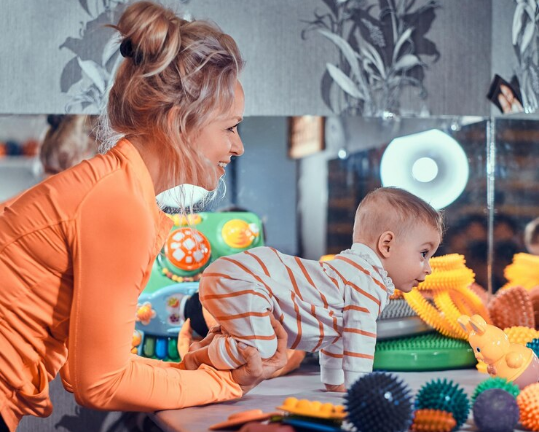It is vital for any parent or caregiver to provide a secure and caring environment for their children. Putting up barriers and securing dangers is only one aspect of child-proofing your house; another is developing a mindset that puts your child’s safety first while encouraging their curiosity and learning. This thorough guide will examine the best methods and viewpoints for successfully child-proofing your house.
Recognizing the Hazards
Prior to putting any child-proofing measures into place, it’s critical to understand the common hazards that exist in every home. The foundation of successful prevention is this understanding. Children are especially vulnerable because of their natural curiosity and lack of awareness of danger. For example, toddlers are constantly exploring and are frequently unaware of the dangers in their surroundings.
Serious injuries from falls or bumps might result from furniture with sharp edges. Despite their seeming innocuousness, small objects can cause serious choking hazards because young toddlers have a natural tendency to put things in their mouths. Safety gates and other obstacles are necessary because stairs provide a risk of falls.

Electrical outlets that are at a child’s eye level can draw curious fingers and, if left unguarded, result in shock or electrocution. Then there are the unstated risks associated with commonplace items; medicines, cleaning supplies, and even some plants have the potential to be hazardous if consumed.
Children’s abilities and areas of interest expand as they get older, altering the hazards they face. Suffocation risks are a major worry for newborns, but toddlers may be able to reach and move more freely, allowing them to come into contact with objects that were previously out of reach. Identifying and comprehending these typical home hazards can help to encourage watchful prevention rather than instill dread, ensuring that the house remains a secure refuge for inquisitive young brains to develop and flourish.
Choosing the Correct Viewpoint
Proactive child proofing is the most successful method. It is not an option to wait for a near miss or, worse, an accident. This entails anticipating your child’s activities rather than only responding to them. Here, empathy is a key component. Getting down on your hands and knees and viewing your house through your child’s eyes can help you identify dangers that you may have missed from your vantage point.
Important Things to Pay Attention to
Every space in your house has unique risks that call for customized solutions.
The kitchen is full with hot surfaces, sharp objects, and perhaps toxic materials. Important measures include locking cupboards, putting breakables and blades out of children’s reach, and never leaving a child alone in the kitchen.
Bathroom: There could be a trip risk here. Use non-slip mats at all times, turn down the water heater to a temperature that is safe for children, and store cleaning supplies and medications securely.
Living Area: Use corner protectors on sharp edges, fasten heavy furniture to the wall to prevent tipping, and make sure toys are stowed securely to avoid trips and falls.
Bedrooms: To prevent choking, make sure windows are shut tightly, furniture is fastened, and toys are suitable for the child’s age.
Hallways and Stairs: To prevent falls, install safety gates, make sure the rails are sturdy, and maintain clean routes.

Instruments and Devices
A plethora of child-proofing items are available, ranging from outlet covers to safety gates. These can be very helpful, but they can’t take the place of awareness and monitoring. Furthermore, a lot of child-proofing techniques work with basic, everyday items that you most likely already have at home and don’t require expensive equipment.
Exploration and Safety in Balance
It can be as harmful to overprotect as it is to underprotect. Children must investigate their surroundings and absorb knowledge from them. Not suppressing this exploration, but rather creating a secure space for it, is the aim. This includes teaching your child about safety and encouraging them to be alert of their surroundings in addition to taking physical safety precautions.
Professional Guidance
Including the counsel of child psychologists, physicians, and safety specialists might yield insightful information. From a more sophisticated standpoint, these professionals are aware of frequent problems and practical child proofing methods.
Frequent Upkeep and Improvements
The process of child proofing is ongoing. Your child’s safety precautions should adapt as they do, and your house should too. To guarantee continued safety, routine inspections and updates are necessary.
Typical Errors to Steer Clear of
A lot of parents underestimate their child’s capacity to overcome challenges or fail to see less evident dangers. Never let a determined child’s inventiveness get the better of you, and always be one step ahead.
Creating a Layout for Your Child-Friendly Home
Establishing Safe Areas: Define’safe zones’ in particular parts of your house where kids can run around unsupervised. To identify these areas, use real obstacles like baby gates.
Furniture Arrangement & Choice: To stop heavy items from toppling over, choose furniture with rounded corners and fasten them to the wall. Think carefully before moving furniture to avoid areas where people could fall.
Recognizing and Avoiding Common Injury Types
Falls are the main reason why kids are hurt at home. Talk about fall prevention techniques including utilizing stair gates and locking windows.
Burns: Stress the value of regulating water heater settings and preventing kids from being near cooking surfaces. Give advice on how to prevent choking and asphyxia by keeping small objects and suffocation dangers, such as plastic bags, out of reach.
Strategies for Preventing Poisoning
Safe Storage: Keep all medications, chemicals, and possibly hazardous plants locked up or out of reach.
Comprehending Labels: Teach people the value of reading and comprehending product labels to identify possible toxins in household items.
Measures for Electrical Safety
Outlet Coverage: Emphasize how crucial it is to use outlet covers or safety plugs to avoid electrocution.
Handling Cords: Give advice on how to secure and keep electrical cords out of the way to avoid tripping or pulling.
Water Safety at Home: Stress the need of using non-slip mats and never leaving a youngster unsupervised in the bathtub.
Securing Hot Tubs and Pools: Talk about the value of alarms, covers, and fences for any hot tubs or pools.
Safety from fires and readiness for emergencies
This article discusses the need of keeping a fire extinguisher close at hand and installing and maintaining smoke alarms.
Plans for emergencies: Emphasize to your family the value of creating and rehearsing an emergency escape plan.
Technology and the Safety of Children
Screen use Management: Talk about how important it is to control and keep an eye on kids’ screen use.
Internet safety: Give advice on how to keep kids safe on the internet, such as using parental controls and having frequent conversations about it.
Proofing Children with Special Needs Customized Safety Measures for Children: Talk about the possible need to modify child-proofing techniques for kids with unique requirements related to their physical, developmental, or sensory needs.
Materials and Assistance: Give directions on where to locate support groups and specialist equipment.
The Supervisor’s Function in Child Safety
Emphasize that although child-proofing is important, attentive monitoring is essential and indispensable for a child’s safety.
Educating Skills for Self-Safety: Talk about how important it is to teach kids age-appropriate basic safety concepts.
Rethink the Steps You Take to Protect Your Children
Frequent Examinations: Emphasize the significance of periodically assessing and modifying child-proofing strategies in light of your child’s growth and acquisition of new abilities.
Getting Knowledge from Near Misses Urge parents to take note of any near-misses or accidents and modify their safety protocols accordingly.
Including Kids in Safety Procedures
Educational Activities: Give kids some suggestions for games and activities that can teach them about safety in an entertaining and interesting way.
Accountability and Guidelines: Talk about how older kids can help keep the family secure by doing things like helping to baby-proof the home for their younger siblings.
Conclusion
Learning, adjusting, and anticipating are all part of the continuous process of child-proofing. It calls for initiative, a thorough awareness of the dangers, and a dedication to establishing a secure atmosphere that promotes learning and development. By adopting this viewpoint, you will give your child lifelong protection from harm in addition to imparting to them important safety and awareness skills.
Materials
Safe Kids Worldwide and The Consumer Product Safety Commission provide a plethora of resources and information for additional reading and educational videos.
FAQs
When should I begin childproofing my home?
There’s always time to get started. It’s a good idea to start implementing safety measures and inspecting your home for possible hazards even before your child starts to crawl.
Can I afford to childproof my house?
Unquestionably. You most certainly already own the items needed to apply many of the child-proofing techniques that work well. A dearth of commercial products can frequently be made up for with creativity and alertness.
You may establish a safe atmosphere that fosters your child’s curiosity and development by being aware of the hazards, adopting the appropriate viewpoint, and continuously adjusting to their developing needs. Child-proofing involves adopting a mindset of safety, awareness, and ongoing learning in addition to just locking up anything that poses a risk.
We hope you found this information helpful in your journey to create a safer environment for your family. At GuardWell Safety, we understand that every home is unique, and so are your child-proofing needs. That’s why we offer a free Child-Proofing Consultation tailored to your specific requirements. Let our experts help you identify potential hazards and provide personalized solutions to make your home a secure haven for your little ones. Book your free consultation today and take the first step towards peace of mind.






